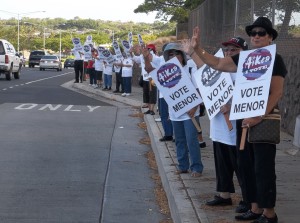AiKea, I Vote!

Dozens of AiKea supporters wave signs in support for Ron Menor for Honolulu City Council
Late last year, Local 5 set an ambitious goal to win three electoral races and kick off a political movement in Hawaii to put control of the state back into the hands of working people, and wrest it away from the corporate powers that dominate decision-making at so many levels throughout the US.
To accomplish this, Local 5 began a comprehensive program to bring its core strength – its rank and file committees – into the political process. Early in 2012, Local 5 committee members organized a series of “town hall” meetings that brought rank and file leaders together with progressive community activists to share and build consensus on key issues – ranging from schools and education to public transportation to water quality, the depletion of fishing resources, and of course, jobs and employment. This program culminated in a mass conference of community and union activists in mid-May to formally launch the “AiKea” movement.
“AiKea” comes from the recognition by the leaders of Local 5 that they needed a name for their movement that appealed to an audience beyond the Union–one that would strike a chord and project hope for change. In the last few years, a street phrase has become popular in Hawaii–a phrase that translated people’s discouragement and disenchantment into fake “Hawaiianized” language. “Ainokea”, when read with Hawaiian pronunciation, sounds “eye-no-kay-ah”, or local pidgin pronunciation for the English words “I no care.” Local 5 decided to turn this phrase around, so it would reflect hope and determination, not discouragement and apathy. That’s how “AiKea” was born.
Focused on three electoral districts, the Local 5 PAC invited candidates seeking the union’s endorsement to participate in a panel discussion before 200 union delegates. This level of participation by union members built both enthusiasm for and commitment to the candidates the union committee chose to endorse.
With a firm relationship in place between Local 5 members and candidates whose values truly reflect those of our members, the union mapped out the neighborhoods and voter turnout goals that were necessary to achieve victory. For two months, Local 5 members and other community activists canvassed these areas, to identify voters and challenge head-on the sense of disempowerment that many voters felt. The message canvassers delivered was a clear departure from the usual get-out-the-vote: working people win respect by building real power, and do so by voting together as part of a movement.
Election night in August proved that all the hours and all the hard work were worth it, as union-supported candidates came out on top in all three races. Now Local 5 is looking forward both toward the November election, but also to the exciting and challenging work of building true organization in the community and challenging workplace leaders to step further into community and political leadership roles.
